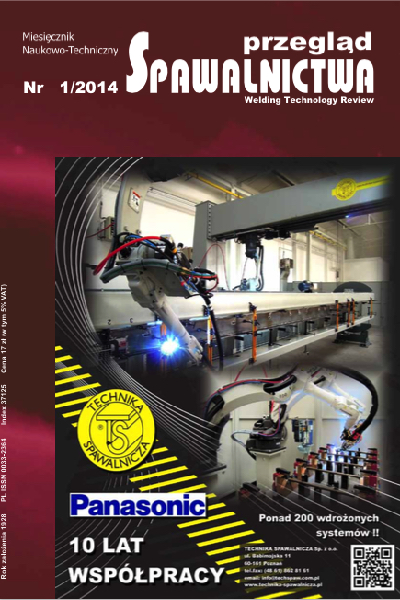Problems of aluminum foam soldering
Main Article Content
Abstract
The cellular structure and unique properties of aluminum foams cause problems with their cutting and bonding. This paper describes the production methods, structure, properties and application of aluminum foams. It also discusses foam cutting methods such as water jet, laser and electrical discharge machining as means of edge preparing for brazing and soldering. Among methods of foam mechanical and weld joining, particular focus is put on brazing and soldering techniques. The limitations and possibilities of aluminum foam brazing and soldering are characterised.
Streszczenie
Komórkowa struktura i wyjątkowe cechy pian aluminiowych są przyczyną problemów z ich lutowaniem. W artykule przedstawiono metody wytwarzania, strukturę, właściwości i zastosowanie pian aluminiowych. Scharakteryzowano również sposoby cięcia pian wodą, laserem i obróbką elektroerozyjną, jako metod przygotowania brzegów do lutowania oraz techniki łączenia pian: mechanicznych i spawalniczych ze szczególnym naciskiem na ich lutowanie miękkie i twarde. Określono ograniczenia i możliwości lutowania pian aluminiowych.
Downloads
Article Details
Creative Commons CC BY 4.0 https://creativecommons.org/licenses/by/4.0/
Welding Technology Review (WTR) articles are published open access under a CC BY licence (Creative Commons Attribution 4.0 International licence). The CC BY licence is the most open licence available and considered the industry 'gold standard' for open access; it is also preferred by many funders. This licence allows readers to copy and redistribute the material in any medium or format, and to alter, transform, or build upon the material, including for commercial use, providing the original author is credited.
References
Grabian J.: Metalowe piany kompozytowe w przemyśle okrętowym, Szczecin 2012.
Kathuria Y.P.: Nd-YAG laser assisted aluminum foaming, Journal of Materials Processing Technology Volume 142, Issue 2, 25 November 2003, s. 466470.
Malekjafarian M., Sadrnezhaad S.K.: Closed-cell Al alloy composite foams: Production and characterization, Materials and Design, 42 (2012) s. 812.
http://tworzywa.com.pl/Wiadomo%C5%9Bci/Pianki-polis- tyrenowe-w-budownictwie-struktura-a-w%C5%82a%C5%9Bc iwo%C5%9Bci-21020.html.
Smitek K.D.: Mietałły Sprawocznik, Mietałłurgia, Moskwa 1980.
Sobczak J.: Piany metalowe monolityczne i kompozytowe oraz gazary, Instytut Odlewnictwa, Kraków 1998.
Banhart J.: Metallic foams II: Properties and Applications. http://materialsknowledge.org/docs/Banhart-talk2.pdf.
Abolghasemi Fakhri M., Bordatchev E. V., Tutunea-Fatan O. R.: An image-based methodology to establish correlations between porosity and cutting force in micromilling of porous titanium foams, Int J Adv Manuf Technol, (2012) 60: s. 841851.
Ashby M.F.: Evans A.G., Fleck N.A., Gibson L.J., Hutchinson J.W., Wadley H.N.G.: Metal Foams: A Design Guide, Butterworth-Heinemann 2000.
Grabian J.: Determination of metal foam flow conditions at a temperature higher than the liqidus temperature, Archives of Foundry Engineering, Vol. 11, 1/2011, s. 2730.
Hyun-Ho K., Soon-Bok L.: Effect of a brazing process on mechanical and fatigue behavior of alclad aluminum 3005, Journal of Mechanical Science and Technology, 26 (7) (2012), s. 21112115.
Weng W.P., Chuang T.H.: Interfacial Characteristics for Brazing of Aluminum Matrix Composites with Al-12Si Filler Metals, Metallurgical and Materials Transactions, A Volume 28A, December 19972673
Yiyou Tu, Zhen Tong, Jianqing Jiang: Effect of Microstruc- ture on Diffusional Solidification of 4343/3005/4343 MultiLayer Aluminum Brazing Sheet, Metallurgical and Materials Transactions, A Volume 44A, April 20131761.
Krajewski S., Nowacki J.: Preparation of aluminium foam edges for welding, Advances in Materials Science, Vol. 13, No. 3 (37), September 2013.
PN-EN ISO 9013:2008 Cięcie termiczne Klasyfikacja cięcia termicznego Specyfikacja geometrii wyrobu i tolerancje jakości.
